I have two David Allen paintings in my two-bedroom condo. Both are winter scenes showing Northfield’s Bridge Square from different angles. In one, the iconic red 1918 popcorn wagon can be seen braving the elements near the Scriver Building. Northfielders know the popcorn wagon is put away after Defeat of Jesse James Days in September until our long winter finally releases its grip sometime in May. What’s up with that?
When I visited Northfield artist David Allen at his studio behind his house on Woodley Street East, he gave me the answer: artistic license. He wanted to include “a splash of red color in the winter,” so he put in this iconic feature of Bridge Square. In truth, since Allen is known for painting places imbued with history and nostalgia, he does not take a lot of liberties with such scenes. Mostly, he told me, he will just put in shadows or light reflections and may move a tree or add a lamp post or a flag pole as it suits his artistic vision. Allen is not an en plein air painter, finding that too time-consuming. He prefers to work from photographs and memory.
Memories! That is Allen’s stock in trade, providing art that brings back memories of familiar places and events of Northfield, his home since 1976. Have you ever fished on Bridge Square? Shopped during a snowy Winter Walk in December? Paused to admire window displays at Quality Bakery or at the Northfield Historical Society museum? Attended one of Northfield’s schools or belonged to one of its churches? Slid down Old Main hill at St. Olaf or at Bell Field at Carleton as a child or with your own children? Do you remember the Ideal Café and Jacobsen’s store, no longer on Division Street? Or St. Olaf’s 1900 dormitory Ytterboe Hall? Allen has captured these memories, among many others, including scenes from Farmington and other nearby communities. But his major focus has been on Northfield, St. Olaf and Carleton colleges.
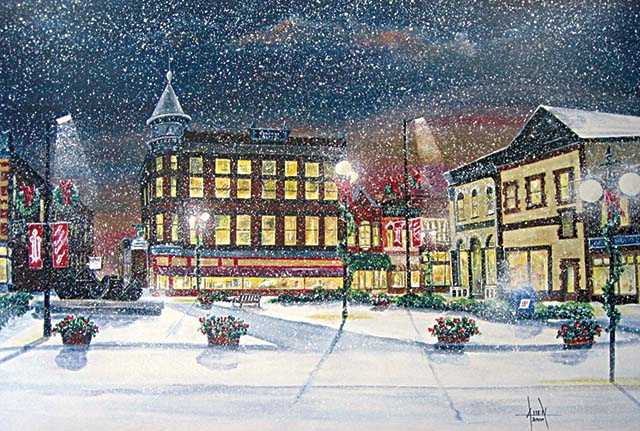
Allen told me he has always been interested in history and is pleased, as an artist, to be able to help preserve local history. He said, “I could paint another 50 years in this town and probably never run out of subject matter. I like to paint things that bring nostalgia to people.” His favorite subject is Bridge Square, in all seasons, “the center of the community,” where people tend to gather. Allen said, “Anyone who ever comes to this town is almost mesmerized by Bridge Square, they just love it,” and he always takes his visitors there, just to “wander around.”
Another favorite topic is train depots, and he has painted ones from Northfield, Montgomery, Farmington, Faribault, New Prague, New Ulm, Rosemount, Kenyon, Rochester, Lakeville, Waseca and Hudson, Wisconsin. His ancestors came from Ireland, arriving in Minnesota by train, and “If it wasn’t for the railroad, it would have been a lot tougher to settle out here.” Allen started painting depots in about 1970 and he said that many depots are disappearing. His wife, Pat, helped the effort to save Northfield’s 1888 depot.

welcoming sight.”
Allen, who grew up in Mankato, was the second of 14 children. His father Richard Allen, from Mineota, had gone to art school at what is now known as the Minneapolis College of Art and Design. After serving in the Pacific with the army during World War II, Richard Allen found work painting murals on the sides of houses and stores. David Allen told me you can still see some of the signs his father painted in southern Minnesota and eastern South Dakota, signs such as “Five cents. Drink Coke” for the Coca Cola Company.
Allen inherited his interest in art from his father. Allen said, “We just always took art for granted. He would let us play with art, paint, do whatever we wanted, so it was just part of the routine…It was the way you grew up.” But with 14 kids and Allen’s grandmother and aunt also living with them, there wasn’t much space for a studio in their house in Mankato, just part of a front porch cordoned off. Richard Allen did commissioned paintings in oil and also became a liturgical art decorator. There was “a lot of scaffolding work, painting pictures of saints and angels, doing filigree work,” with help from David and his older brother, Dick. Among David’s siblings, brother Dick became a novelist and two of his sisters, Mary and Katie, are professional singers. Only David Allen became a visual artist.

David Allen graduated from Loyola High School in Mankato in 1961, and served in the U.S. Army in Germany from 1961 to 1964. He then worked for a couple years in a steel mill in Detroit until “I decided that wasn’t my calling,” and he returned to Mankato. There he got a B.S. degree in art and special education in 1970 from Mankato State University and married his high school sweetheart, Pat Reedy, in 1967.
After college, Allen started teaching special education and then art at Rosemount High School and also established a work program for at-risk kids. As Allen explained it, “Kids would have to take a class on how to be able to work, how to get jobs, how to keep jobs,” learning life skills. The students would be released from school to work and “Then we as teachers would monitor their work so that they would be successful.” Allen said it was a very rewarding program, watching kids blossom and “get a sense of who they are” as they then went on to careers.

Allen was commuting to his work in Rosemount from St. Paul, but when their son, Sean, reached school age, the Allens, with two younger daughters, decided they wanted to move to a better environment and a smaller community. Allen had been participating in the Northfield Arts Guild Arts Festival during Defeat of Jesse James Days since 1970 and when they found their 1899 home on Woodley Avenue East, they became Northfield residents in 1976. Allen said that he noticed “right off the bat” that “everybody was friendly and welcoming, and it’s just a beautiful place” which has been kept that way, with a “taste of the old homestead, the old prairie towns that I really liked and still do.” All three of their children went to Northfield schools. Sean now is a real estate developer in Rochester. Daughter Megan Tsui lives in Red Wing and is executive director of the Northfield Enterprise Center, assisting businesses and leading the Spur co-working program. Daughter Bridget Reuvers lives in Northfield and drives a school bus here.
In 1986, Allen and four other teachers started a new school under district guidelines, the Rosemount Alternative Learning Center, with Allen as the art teacher. It was “for kids that were dropouts, or having trouble, or just didn’t want to be in school in Rosemount,” Allen said. This was his work for 26 years. Besides teaching art, he taught shop, English and some auto mechanics, “whatever they wanted me to teach, I would teach it. And it was a blast, I enjoyed it.” In total, he taught 43 years in Rosemount and has been retired for the past year. Allen laughed as he said, “And I’m getting used to it. I don’t like it, but I’m getting used to it.”
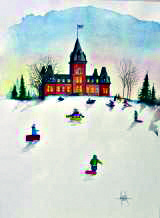
Could Allen have made a living just as an artist? He replied, with another laugh, “If I wasn’t teaching, I’d be a lot skinnier than I am now.” But he had a family to support, and he loved teaching. For two Septembers since retirement he has been artist-in-residence at the Rosemount Middle School, doing such things as demonstrating watercolor and acrylic techniques and helping with clay classes. Allen said, “I like kids, so it’s perfect.” As a visiting artist, “I don’t have to discipline them anymore.”
Of course, retirement means more time for his art, but Allen told me that over the years, “I would try to every day do something with art, an hour, two hours.” Allen’s father always told him, “Inspiration comes from work, work does not come from inspiration,” and he adheres to that. Allen said, “So the more you work, the more inspired you become, so that’s why I always emphasized you have to keep working.” Artists feel compelled to work anyway: “It’s just part of you, you have to do it.” And Allen feels lucky that, as an artist, he still has this artistic calling to keep him busy.
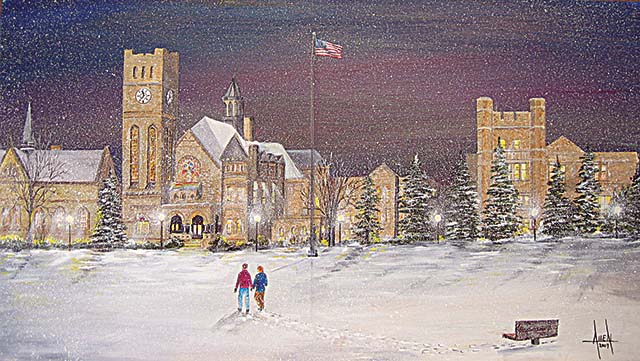
When the Allens first moved to Northfield, their house came with a chicken coop in the back that he tried to retrofit for a studio. Even after adding a woodstove, “I’d come out in the morning and all my paints would be frozen.” So he painted in a corner of the family room for many years, then in a studio addition built onto the house. Needing more room, in 2012 he replaced the coop with a big garage which serves a variety of purposes, besides sheltering cars. (“My kids call it the Garage-Majal,” Allen said.) There is a greenhouse, with ten-foot-tall windows, with Allen’s studio on the second floor. Near the cars is a space for welding.
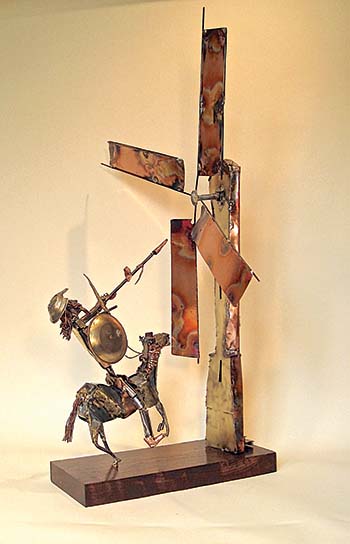
Welding? Yes. Though he mostly does metal sculptures in the spring and summer, and paints acrylics and watercolors during the winter, Allen can now weld year round. This aspect of Allen’s art is not as well-known as his painting, but he has actually worked with welding since starting in a college shop. It was not a class; he said, “I kind of taught myself.” And his work was abstract, which was “all the rage in the ’60s.”
Allen’s welding found a focal point in the mid-1970s. Allen’s interest had been piqued in college when he had read Cervantes’ immortal tale about Don Quixote fighting those windmills which he had mistaken for giants, along with his sidekick Sancho Panza. Allen considers Quixote to be “just a timeless figure of people having their dreams and visions and following them – crazy as he was, he followed them.” Allen began painting this Quixote theme in 1970, with welding taking over by the mid-1970s. He has produced Quixotic works ranging from eight inches tall to seven feet tall. Allen estimates each takes about eight to ten hours to complete.

And this year Allen has added a surrealistic painting of Don Quixote to his oeuvre. Allen said this has come out of his love of doodling shapes, which has in turn led to a series of boldly colorful paintings. Allen’s surrealistic works are inspired by the mustachioed Spanish artist Salvador Dalí, whose images of melting pocket watches in The Persistence of Memory (1931) are widely recognized. Whenever Allen is in Florida, he makes a stop at the Salvador Dalí Museum in St. Petersburg which has the largest collection of Dalí’s work outside of Spain. Allen said that Dalí is “my absolute hero,” another “crazy guy” like Quixote, but “just so talented.”

Another sculptural theme was born when David and Pat Allen visited their son when he was in the Peace Corps in Paraguay and noticed elderly women and men feeding birds in the village square. “That was their entertainment, all day long,” a scene Allen saw repeated in other countries such as Italy. Allen liked the “communication between human beings and animals,” and made sculptures of people feeding pigeons, ducks, chickens and seagulls, sometimes softening the iron of the work by incorporating ceramic creatures.
He has also made a bird lady of shiny mesh which originally was to be covered by clay but which he decided gave a “nice airy feeling.” So now he will start doing other sculptures in this way.

Allen does commissioned paintings of homes, businesses, farms and other locales which are often given as Christmas and birthday presents, charging $300 for a watercolor, $375 for an acrylic. If it is to be a surprise, Allen will make stealthy forays to take pictures or use pictures provided. Such works become family heirlooms. He has just started to market personalized paintings of the Grand Event Center, with “your name here” on the marquee, for $75 for a print and $300 for a personalized original. (He first did this for his own daughters after their wedding receptions were held at the Grand.) Allen also sells greeting cards for $4 each and is currently selling 25 different scenes from Northfield, Carleton and St. Olaf colleges, New Prague and Montgomery.
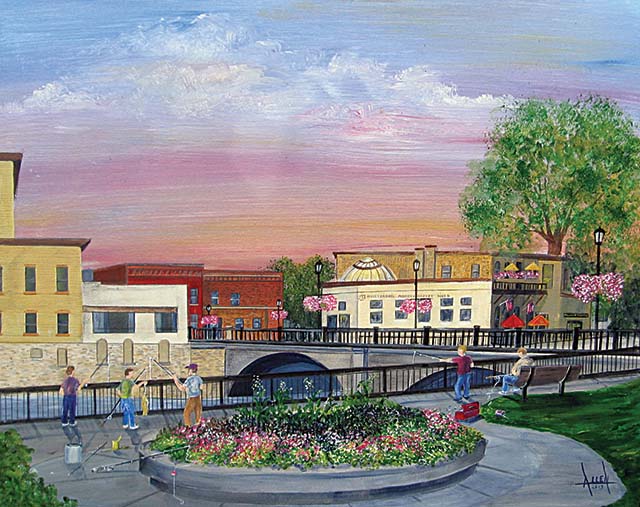
Allen told me, “I like painting the pictures, but I like people to have them,” so he makes sure his work is affordable. He has set a $75 charge for all his prints, with acrylics and watercolors ranging from $150 to $350. Allen’s art can be seen at davidallenart.com and facebook.com/davidallenart. He may also be reached at 507/645-9298.


Thanks to artist (and 1966 St. Olaf graduate) L.K. Hanson for his illustration of David Allen. Hanson was featured in “Historic Happenings” in our October 2010 Visual Arts issue.






